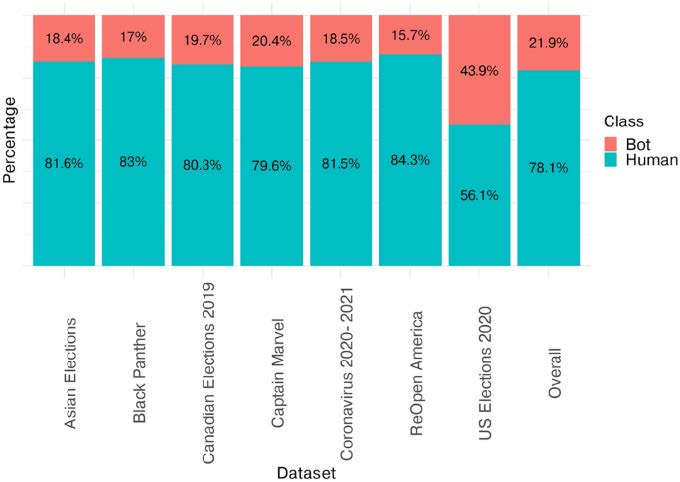
What is a Social Media Bot?
By Lynnette Ng
Tags: social media bot, global comparison
Image credit: Lynnette Ng
Keywords: social media bot, global comparison
Associated Publication:
Ng, L.H.X., Carley, K.M. A global comparison of social media bot and human characteristics. Sci Rep 15, 10973 (2025). https://doi.org/10.1038/s41598-025-96372-1
New research reveals critical differences between bots and humans on social media, and shows the consistency of bots across global events.
What is a social media bot?
The term “bot” is commonly used to refer to seemingly inauthentic content. Most social media users know what is a bot and can point out bot-like users, but there is no universal definition of a bot. After surveying studies of social media bots, we describe the bot based on three main characteristics present in all social media platforms: user, content and interactions.

This is a generic definition of a bot. Many studies focus on malicious bots, and how they manipulate information, spam messages and influence users, however, a bot is a neither good nor bad. A bot is, in essence, a computer algorithm. It is the usage of the bot that makes it good or bad.
In fact, the social media bot is an AI algorithm. It perceives the digital environment, and intelligently post content and perform interactions to achieve its goal. Bots are ubiquitous in the social media world. In this study, we analyzed over 200 million social media users across 7 global events to answer these two questions:
- How many bots are there on social media?
- What are the differences between bots and humans? Are these differences consistent across social media?
Finding 1: ~20% Bots across All Events
On average, the bot volume across the events are about 20%. This estimate is empirically consistent with Elon Musk’s 2022 estimate, when he declared there were about 20% bot users during his purchase of Twitter / X. This finding is important for event analysis because it provides a comparison baseline towards the percentage of bot-like users within an event. Spikes in bot user percentage beyond 20% suggests that the event and conversation has caught the interest of bot operators, and
analysts should monitor for signs of conversation manipulation.

Finding 2: Consistent bot-human differences
We found consistent differences between bots and humans across several axes of investigation.
- Difference in psycholinguistic cues: Bots tweet with cues that can be easily and heavily automated (e.g., retweet), while humans construct more personal tweets that require higher cognitive processing to create (e.g., use of sentiment cues, replies)
- Difference in self-presentation: Bots converse mostly about topics that match their identity, showing a curated presentation and allows for an aspect of predictability.
- Difference in communication strategies: Bots and humans actively form communication with other humans. Bots commonly use a star structure in political discourse, while humans are more likely to be part of a tree-structure. The star structure of bots suggests they have a hierarchy of interconnected users to disseminate information, which is easily achieved with the help of automation. On the other hand, humans communicate predominately within their immediate network before extending their communication outwards.

Implications for Platforms and Policy-Makers
These findings can help us design better solutions and platforms going forward.
- Leverage Bot Characteristics for Social Good – Based on the possible avenues for interacting with bots, we provide suggestions on how bots can be leveraged for social good. These suggestions are based off the results in the study.
- Bots use more abusive and expletive terms than humans => focus regulation to disallow bots to use toxic language
3. Detect, Differentiate, Disrupt – This phrase outlines continued challenges to studying social media bots, and opportunities for future research. The first step is to systematically detect these bots, and future work leads to characterizing archetypes of interaction patterns. The second is to differentiate the goodness of the bot and its function, which can provide insight towards possible impact of the bot. Last is to design interventions to mindfully disrupt the operations of malicious bots.
As social media bots continue to evolve and change, our strategies to combat it must as well. This study shows the consistency of bot techniques across the global scale providing a foundation for understanding bot strategies, informing policy designs.
